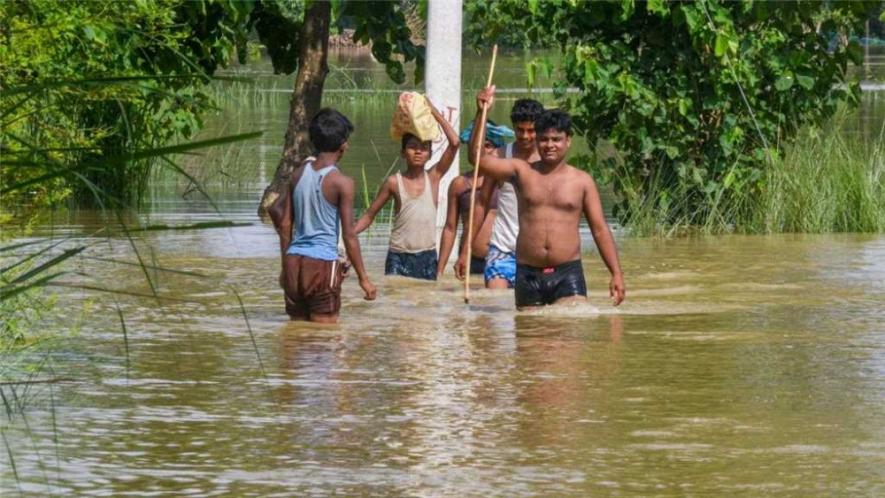Heavy Rains Worsen Bihar Flood Situation, Record Barrage Water Released Into Koshi, Gandak

Image Courtesy: The Morung Express
Patna: Heavy rains worsened flood situation in Bihar after there was record discharge of barrage water into Koshi and Gandak rivers.
Patna: The flood situation in Bihar worsened on Tuesday amid the worsening COVID-19 pandemic, following heavy monsoon rains continuing for the past three days in the catchment area of major rivers in neighbouring Nepal. With the rivers in spate, the authorities were forced to released record water from the barrage into rivers Koshi and Gandak on Tuesday.
According to reports reaching here, flood water entered hundreds of villages and spread in new areas in the flood-affected districts of North Bihar in the past 24 hours. In several places, flood water submerged vast low-lying areas and flowed three-to-four feet high on roads, including national highways.
The state government has issued a high alert in over half a dozen districts in view of the rising water levels in all major rivers and has asked district officials to be ready to face any eventuality.
The fear of devastating floods has forced thousands to flee their homes and shift to higher places.
According to officials of the Water Resources Department (WRD), the pressure on embankments increased after discharge of record barrage water into rivers. “The water levels of rivers have been rising to danger and extreme danger levels at several places, putting pressure on the embankments,” the officials said.
Authorities have opened 48 of the total 56 sluice gates of Koshi barrage at Birpur in Nepal after the water level rose to an alarming level on July 21.This barrage is managed and maintained by WRD of Bihar.
According to WRD officials, the barrage discharged 327,000 lakh cusecs of water into Koshi river on Tuesday noon. Water discharge from the barrage has been increasing and decreasing in the past 24 hours, depending on rains in catchment areas. On Tuesday, 340,000 lakh cusecs was discharged at 11 am, on Monday night, 260,000 lakh cusecs was discharged.
Similarly, the barrage at Valmikinagar discharged 416,000 lakh cusec into Gandak river.
After heavy discharge of water from both barrages, Chief Minister Nitish Kumar has reportedly instructed the state disaster management department (DMD) to be on high alert, as the India Meteorological Department (IMD) has forecast heavy rainfall across Bihar for the next three days.
WRD principal secretary Sanjeev Hans said: “We are trying to protect all embankments to minimise the chances of any breach”.
Meanwhile, DMD officials, along with local administrative officials, have been appealing to people in low-lying areas to shift to higher places.
As per official DMD data, 3.5 lakh people were been affected by the floods in the state till Monday. The number of affected people is increasing by the day. There were 2.92 lakh flood-affected people on July 18.
However, unofficial figures have put the number to more than 10 lakh affected people in the state.
According to official reports,190 panchayats in 34 blocks in eight flood-prone districts of Muzaffarpur, Gopalganj, Sitamarhi, Sheohar, Supaul, Kishanganj, Darbhanga, and East Champaran have been affected.
The flood situation remained grim in several other districts, including Madhepura, Khagaria, Katihar, Madhubani, Purnea, Araria and Bhagalpur.
According to Central Water Commission officials, other than Koshi and Gandak, all major rivers, including Kamla Balan, Bhuthi Balan, Bagmati, Mahananda, Burhi Gandak, Adhwara, Lal Bakeya and Ghaghra are maintaining a rising trend with most of them flowing above the danger mark at few places.
The Pandemic Factor
The fear of floods and flash floods during monsoons is not new in Bihar. But, what has worried thousands of people his year is that flood control measures were not completed till June 25. The government has been citing the lockdown due to COVID-19 pandemic as a reason for the delayed work, which was completed in a hurry.
After the sudden country-wide lockdown began on March 25, most of the anti-erosion work, including projects for embankment repair and maintenance, came to a standstill till mid-May. Work resumed only after the government eased the lockdown.
This reality is reflected on-ground as anti-erosion work is still on, though there was urgency to complete it by June 30 at any cost. However, the monsoon hit the state on June 13. So far, 350 of a total of 388 anti-erosion and flood protection works have been completed, officials said.
According to WRD’s website, Bihar is the most flood-affected state, accounting for close to 17.2% of the total flood-prone area in the country. Out of 94.16 lakh hectare area, 68.80 lakh ha (76% of North Bihar and 73% of South Bihar) is flood-prone. At present, 28 out of 38 districts in the state are flood-prone.
The flood management works that can be carried out include the construction and maintenance of embankments, revetment in selected portions of river banks, land spurs and other necessary flood-protection work. A large part of river catchment areas fall in the glacial regions of the Himalayas. Thus, remedial measures for flood protection in Bihar are critical.
As a long term measure, the construction of storage reservoirs and extensive watershed treatment in the upper catchments of rivers is considered essential. For the short-term, the construction of embankments along the rivers was done; by constructing about 3,745.96 km of embankment, around 36.46 lakh ha of area has been brought under a reasonable degree of protection.
However, the existing embankments are under increasing pressure due to the rise in the river bed levels due to heavy silt brought down by the rivers from Nepal. Due to abnormal changes in river courses, anti-erosion work for the protection of embankments, and essential flood-fighting work, is imperative each year. But, due to delay in the work this year, the flood situation may take a turn for the worse.
Get the latest reports & analysis with people's perspective on Protests, movements & deep analytical videos, discussions of the current affairs in your Telegram app. Subscribe to NewsClick's Telegram channel & get Real-Time updates on stories, as they get published on our website.























